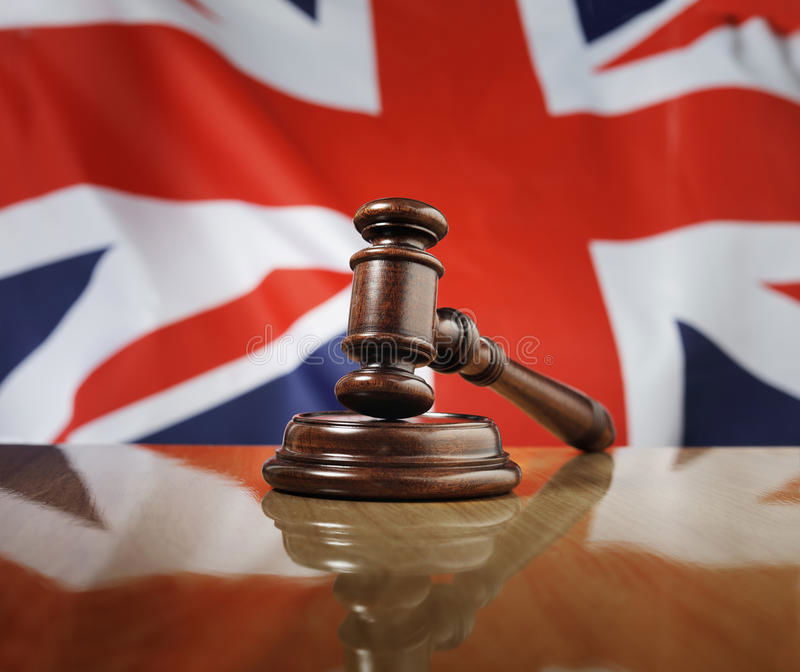United Kingdom law enforcement
Free Shipping on US orders over $49 USD and 5 lbs or less at eVitamins.com!
Law enforcement in the United Kingdom
Jump to navigationJump to search
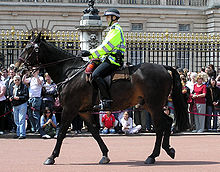 Mounted officer of the Metropolitan Police at Buckingham Palace, London
Mounted officer of the Metropolitan Police at Buckingham Palace, LondonLaw enforcement in the United Kingdom is organised separately in each of the legal systems of the United Kingdom: England and Wales, Northern Ireland and Scotland.[nb 1] Most law enforcement is carried out by police officers serving in regional police services (known as territorial police forces) within one of those jurisdictions. These regional services are complemented by UK-wide agencies, such as the National Crime Agency and the national specialist units of certain territorial police forces, such as the Specialist Operations directorate of the Metropolitan Police.
Police officers are granted certain powers to enable them to execute their duties. Their primary duties are the protection of life and property, preservation of the peace, and prevention and detection of criminal offences.[1] In the British model of policing, officers exercise their powers to police with the implicit consent of the public. "Policing by consent" is the phrase used to describe this. It expresses that the legitimacy of policing in the eyes of the public is based upon a general consensus of support that follows from transparency about their powers, their integrity in exercising those powers and their accountability for doing so.[2][3]
Contents
- 1History
- 2Jurisdictions and territories
- 3Powers of officers
- 4Accountability
- 5Operations
- 6Issues
- 7See also
- 8Notes
- 9References
- 10External links
History[edit]
Main article: History of law enforcement in the United Kingdom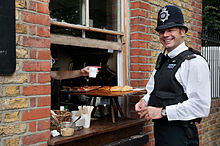 A police officer on his lunch break
A police officer on his lunch breakIn the 18th century law enforcement and policing were organised by local communities based on watchmen and constables; the government was not directly involved in policing. The City of Glasgow Police, the first professional police, was established following an Act of Parliament in 1800.[4] The first centrally organised police force in the world was created in Ireland, then a part of the United Kingdom, following the Peace Preservation Act in 1814 for which Sir Robert Peel was largely responsible.[5]
London had a population of nearly a million and a half people in the early 19th century but was policed by only 450 constables and 4,500 night watchmen.[6] The concept of professional policing was taken up by Sir Robert Peel when he became Home Secretary in 1822. Peel's Metropolitan Police Act 1829 established a full-time, professional and centrally-organised police force for the greater London area known as the Metropolitan Police.[7] Legislation in the 1830s introduced policing in boroughs and many counties and, in the 1850s, policing was established nationally.
The Peelian principles describe the philosophy that Sir Robert Peel developed to define an ethical police force. The principles traditionally ascribed to Peel state that:[8][9]
- Every police officer should be issued a warrant card with a unique identification number, to assure accountability for his actions.
- Whether the police are effective is not measured on the number of arrests, but on the lack of crime.
- Above all else, an effective authority figure knows trust and accountability are paramount. Hence, Peel's most often quoted principle that "The police are the public and the public are the police."
Nine principles of policing were set out in the 'General Instructions' issued to every new police officer in the Metropolitan Police from 1829. However, the Home Office has suggested this list was more likely authored by Charles Rowan and Richard Mayne, the first and joint Commissioners of the Metropolitan Police.[10][11]
The police historian Charles Reith explained in his New Study of Police History (1956) that these principles constituted a philosophy of policing "unique in history and throughout the world because it derived not from fear but almost exclusively from public co-operation with the police, induced by them designedly by behaviour which secures and maintains for them the approval, respect and affection of the public".[10][12] This approach to policing became known as "policing by consent".[11]
The first women police officers were employed during the First World War. Hull and Southampton were two of the first to employ women police, although Grantham was the first town to have a warranted policewoman.[13]
Since the 1940s, police forces in the United Kingdom have been merged and modernised.
Corruption at the Metropolitan Police's Flying Squad led to a conviction and resignations in 1977 after the Operation Countryman investigations. A Police Complaints Board was set up to handle allegations of malpractice in response.
Changes took place to tighten police procedures in the 1980s, in response to the Scarman Report, to ensure that evidence and interviews were robust, in the introduction of the Police and Criminal Evidence Act 1984. In 1989, the West Midlands Serious Crime Squad was disbanded as a series of around 100 criminal cases failed or were subsequently overturned in the West Midlands, after new forensic techniques showed police officers had been tampering with statement evidence to secure convictions, including those of the Birmingham Six.
The Police Complaints Board was replaced by the Police Complaints Authority in 1985, which itself was superseded by the Independent Police Complaints Commission in 2004. On 8 January 2018, the IPCC was replaced by the Independent Office for Police Conduct.[14]
Jurisdictions and territories[edit]
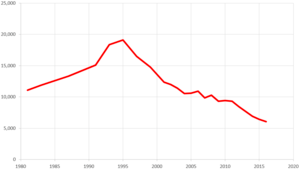 Crime in England and Wales from the Crime Survey (in 000s of crimes).[15]
Crime in England and Wales from the Crime Survey (in 000s of crimes).[15]In the United Kingdom, every person has limited powers of arrest if they see a crime being committed: at common law in Scotland, and in England and Wales if the crime is indictable[16] – these are called "every person powers", commonly referred to as a "citizen's arrest". In England and Wales, the vast majority of attested constables enjoy full powers of arrest and search as granted by the Police and Criminal Evidence Act 1984. For the purposes of this legislation, "constables" is defined to mean all police officers, irrespective of rank. Although police officers have wide-ranging powers, they are still subject to the same laws as members of the public (aside from specific exemptions such as the carrying of firearms and certain road traffic legislation). There are additional legal restrictions placed on police officers such as the prohibitions on industrial action and on taking part in active politics.
Types of law enforcement agency[edit]
Main article: List of law enforcement agencies in the United KingdomThere are three general types of law enforcement agency in the United Kingdom. The first is mostly concerned with policing the general public and their activities and the others are concerned with policing of more specific matters:
- Territorial police services, which carry out the majority of policing. There are 45 territorial police services as of 2013 that cover a police area (a particular region) and have an independent police authority (England and Wales) or local authority or joint police board (Scotland). The Police Act 1996, the Police (Scotland) Act 1967 and the Police (Northern Ireland) Act 2000, prescribe a number of issues such as appointment of a chief constable, and jurisdiction and responsibilities for police forces in England and Wales, Scotland and Northern Ireland respectively. Since the introduction of Police and Crime Commissioners in November 2012, the police services in England and Wales no longer have a police authority and this work is done by the police and crime prevention commissioners who are elected every four years. Certain territorial police services have units within them which have a national role, such the Specialist Operations directorate of the Metropolitan Police.
- National law enforcement agencies, including the National Crime Agency and British Transport Police (the latter only operates in Great Britain). The Serious Organised Crime and Police Act 2005 refers to these as "special police forces". The National Crime Agency operates across the United Kingdom (but in Scotland or Northern Ireland requires the agreement of the domestic prosecuting authority to do so) against organised crime and acts as the UK point of contact for foreign agencies. There are also non-police law enforcement agencies whose officers, while not police constables, enforce laws such as the Serious Fraud Office and HM Revenue and Customs.
- Miscellaneous police services, mostly having their foundations in older legislation or common law. These have a responsibility to police specific local areas or activities, such as ports and parks, and before the passing of recent legislation such as the Serious Organised Crime and Police Act 2005 were often referred to as "special police services"; care must therefore be taken in interpreting historical use of that phrase. These constabularies are not within the scope of the legislation applicable to the previously mentioned organisations but can still be the subject of statutes applicable to, for example, docks, harbours or railways. Until the passing of Railways and Transport Safety Act 2003, the British Transport Police was such a force.
The list of law enforcement agencies in the United Kingdom details the various services.
Cross-jurisdiction powers[edit]
Territorial police constables have certain powers of arrest in another one of the UK's three legal jurisdictions than they were attested in. There are four main provisions for them to do so – arrest with a warrant, arrest without a warrant for an offence committed in their home jurisdiction whilst in another jurisdiction, arrest without a warrant for an offence committed in another jurisdiction whilst in that jurisdiction, and mutual aid. A fifth power of cross jurisdictional arrest was introduced by section 116 of the Policing and Crime Act 2017 which fills a loop hole in arrest powers in certain situations. This power came into force in March 2018.[17] This new power allows a constable from one jurisdiction to arrest without warrant a person suspected of an offence in another jurisdiction whilst in their home jurisdiction. This power is in relation to more serious offences as listed in the act. The Act sets out how long the person can be detained in custody by the 'arresting force' in one jurisdiction until constables from the 'investigating force' in another jurisdiction can travel to re-arrest the person and deal accordingly.[18] Below is a summary of these five powers with a practical example due to the complicated nature of this area of law. Note: this section applies to territorial police constables only, and not to others – except the British Transport Police, who also have certain cross-border powers in addition to their natural powers.
Arrest with warrant[edit]
Certain warrants can be executed by constables even though they are outside their jurisdiction: arrest warrants and warrants of committal (all); and a warrant to arrest a witness (England, Wales or Northern Ireland); a warrant for committal, a warrant to imprison (or to apprehend and imprison), and a warrant to arrest a witness (Scotland).[19] A warrant issued in one legal jurisdiction may be executed in either of the other two jurisdictions by a constable from either the jurisdiction where it was issued, or the jurisdiction where it is executed.[19]
When executing a warrant issued in Scotland, the constable executing it shall have the same powers and duties, and the person arrested the same rights, as they would have had if execution had been in Scotland by a constable of a police force in Scotland. When executing a warrant issued in England & Wales or Northern Ireland, a constable may use reasonable force and has specified search powers provided by section 139 of the Criminal Justice and Public Order Act 1994.[20]
Arrest without warrant: offences committed in home jurisdiction[edit]
In very simple terms, this power allows constables of one jurisdiction to travel to another jurisdiction and arrest a person they suspect of committing an offence in their home jurisdiction. For example, constables from Cumbria Police investigating an offence of assault that occurred in their police area could travel over the border into Scotland and arrest the suspect without warrant found in Gretna.
If a constable suspects that a person has committed or attempted to commit an offence in his legal jurisdiction, and that person is now in another jurisdiction, he may arrest them in that other jurisdiction.[21]
A constable from England & Wales is subject to the same necessity tests for arrest (as under section 24 of the Police and Criminal Evidence Act 1984[22]) as he would be in England & Wales, a constable from Scotland may arrest if it would have been lawful to do so in Scotland and a constable from Northern Ireland is subject to the same necessity tests for arrest (as under Article 26 of the Police and Criminal Evidence (Northern Ireland) Order 1989.[23]) as he would be in Northern Ireland.[21]
A person arrested under the above powers:[21]
- in Scotland, shall be taken to the nearest convenient designated police station or to a designated police station in a police area in which the offence is being investigated (England & Wales or Northern Ireland),
- in England or Wales, shall be taken to the nearest convenient police station (Scotland) or to a police station within a sheriffdom in which the offence is being investigated (Scotland), to the nearest convenient designated police station (Northern Ireland) or to a designated police station in which the offence is being investigated (Northern Ireland), or
- in Northern Ireland, shall be taken either to the nearest convenient designated police station (England & Wales) or to a designated police station in a police area in which the offence is being investigated (England & Wales) or to the nearest convenient police station (Scotland) or to a police station within a sheriffdom in which the offence is being investigated (Scotland).
Arrest without warrant: offences committed in other jurisdictions (known as reciprocal powers of arrest)[edit]
In simple terms, this power gives a constable of one jurisdiction whilst in another jurisdiction the same power of arrest as a constable of the jurisdiction they are visiting. As a practical example, if constables from Police Scotland are over the border in Cumbria on enquiries and come across a burglary in progress they can arrest the suspect on suspicion of burglary using the same arrest powers as a constable of England or Wales.
A constable from one legal jurisdiction has, in the other jurisdictions, the same powers of arrest as a constable of that jurisdiction would have.[24]
A constable from England or Wales has:[24]
- in Scotland, the same power of arrest as a constable from Scotland
- in Northern Ireland, the same power of arrest as a constable from Northern Ireland would have under Article 26 of the Police and Criminal Evidence (Northern Ireland) Order 1989 (necessity test).[25]
A constable from Scotland has:[24]
- in England and Wales, the same power of arrest as a constable from England or Wales would have under section 24 of the Police and Criminal Evidence Act 1984 (necessity test).[26]
- in Northern Ireland, the same power of arrest as a constable from Northern Ireland would have under Article 26 of the Police and Criminal Evidence (Northern Ireland) Order 1989 (necessity test).[27]
A constable from Northern Ireland has:[24]
- in Scotland, the same power of arrest as a constable from Scotland
- in England and Wales, the same power of arrest as a constable from England or Wales would have under section 24 of the Police and Criminal Evidence Act 1984 (necessity test).[26]
When a constable arrests a person in England & Wales, the constable is subject to the requirements of section 28 (informing of arrest),[28] section 30 (taking to a designated police station)[29] and section 32 (search on arrest).[24][30] When a constable arrests a person in Scotland, the arrested person shall have the same rights and the constable the same powers and duties as they would have were the constable a constable of a police force in Scotland.[24] When a constable arrests a person in Northern Ireland, the constable is subject to the requirements of Article 30 (informing of arrest),[31] Article 32 (taking to a designated police station)[32] and Article 34 (search on arrest).[24][33]
Arrest without warrant by a constable in his home jurisdiction for an offence committed in another jurisdiction[edit]
This relatively new power was introduced by the Policing and Crime Act 2017 and came into force in March 2018.[17] Until the introduction of this power, there was an issue whereby a constable in his home jurisdiction could not arrest a person suspected of an offence in another jurisdiction without a warrant.[34] Practically this meant that either a warrant had to be applied for, or constables from the investigating force have to travel to the jurisdiction where the person suspected was believed to be, to arrest under the cross border powers set out above. In urgent and serious cases this caused several issues around delay and suspects evading capture. This new power allows a constable of one jurisdiction to arrest without warrant a person suspected of an offence in another jurisdiction whilst in their home jurisdiction. The Act sets out which offences this power of arrest will apply to in each jurisdiction (generally serious offences), and how long the person arrested can be kept in custody, with relevant authorities, by the "arresting force" to allow sufficient time for officers from the "investigating force" in another jurisdiction to travel and re-arrest the detained person for the purposes of their investigation.[18]
As a practical example of this power, a murder is committed in Aberdeen, Scotland. The suspect immediately travels south over the border into England and is found by constables of Cumbria Police in Carlisle. These constables would have a power of arrest in relation to the homicide that occurred in Scotland without the need to have a warrant.
Other situations (including Mutual Aid)[edit]
Police forces often support each other with large-scale operations, such as those that require specialist skills or expertise and those that require policing levels that the host-forces cannot provide. Referred to as mutual aid, constables loaned from one force to another have the powers and privileges of a constable of the host force.[35] Constables from the Metropolitan Police who are on protection duties in Scotland or Northern Ireland have all the powers and privileges of a constable of the host police force.[36] A constable who is taking a person to or from a prison retains all the powers, authority, protection and privileges of his office regardless of his location.[37] Regardless of where they are in the United Kingdom, a constable may arrest under section 41[38] and may stop and search under section 43[39] of the Terrorism Act 2000 on suspicion of terrorism (defined by section 40[40]).
Powers of officers[edit]
Territorial police constables[edit]
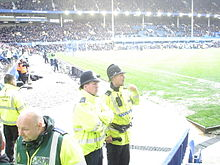 An officer of the Metropolitan Police with an officer of Merseyside Police during a Football match between Everton and West Ham at Goodison Park
An officer of the Metropolitan Police with an officer of Merseyside Police during a Football match between Everton and West Ham at Goodison Park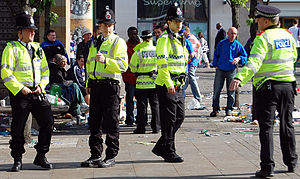 Police Constables and an Inspector of Greater Manchester Police on the beat in Manchester city centre after the 2008 UEFA Cup Final Riots
Police Constables and an Inspector of Greater Manchester Police on the beat in Manchester city centre after the 2008 UEFA Cup Final RiotsMost police officers are members of territorial police forces. A person must make a declaration before taking up office as a constable and having any powers; although this is sometimes still known as the police oath, and the process sometimes referred to as "swearing in", it now takes the form of an "attestation" (in England and Wales and Northern Ireland) or a "declaration" (in Scotland). The process is carried out in the presence of a magistrate, and is usually followed by the issue of a warrant card. This grants the officer all the powers and privileges, duties and responsibilities of a constable in one of the three distinct legal systems - either England and Wales, Scotland or Northern Ireland, and the territorial waters of that country. The limited circumstances where their powers extend across the border are described in the section above.
Other constables[edit]
There are many constables who are not members of territorial police forces. The most notable are members of the three forces referred to as special police forces: the British Transport Police, Ministry of Defence Police and Civil Nuclear Constabulary. Such officers have the "powers and privileges of a constable" in matters relating to their work.[41][42][43] BTP and MDP officers have additional jurisdiction where requested by a constable of another force, in which case they take on that constable's jurisdiction.[44][45] Upon request from the chief police officer of a police force, members of one of the above three forces can be given the full powers of constables in the police area of the requesting force.[44][46] This was used to supplement police numbers in the areas surrounding the 2005 G8 summit at Gleneagles.
Many acts allow companies or councils to employ constables for a specific purpose. There are 10[47] companies whose employees are sworn in as constables under section 79 of the Harbours, Docks, and Piers Clauses Act 1847. As a result, they have the full powers of a constable on land owned by the harbour, dock, or port and at any place within one mile of any owned land. There are also forces created by specific legislation, such as the Port of Tilbury Police (Port of London Act 1968), Mersey Tunnels Police (County of Merseyside Act 1989) and the Epping Forest Keepers (Epping Forest Act 1878).
Parks Constables[edit]
Under Article 18 of the Ministry of Housing and Local Government Provisional Order Confirmation (Greater London Parks and Open Spaces) Act 1967, London Borough Councils are allowed to swear in council officers as constables for "securing the observance of the provisions of all enactments relating to open spaces under their control or management and of bye-laws and regulations made thereunder". Local Authority Parks Constables have all the powers of a constable in relation byelaws regulations and all enactments relating to open spaces, Article 19 of the Act was repealed by section 26(1) of the Police and Criminal Evidence Act 1984 (Local Acts) and the power of arrest for Parks Constables is now contained in Section 24 of P.A.C.E 1984, further amendments to Article 19 covering coming to the aid and assistance of such a constable or officer were repealed by SOCPA 2005, as this provision is already covered in P.A.C.E 1984 (Legal Counsel 2007,2012). No enforcement agency with a power of arrest or detention can operate outside of the provisions of P.A.C.E 1984; therefore all local powers of arrest and detention were brought into line under section 26(1) P.A.C.E 1984.
Police staff[edit]
Police forces employ staff who perform many functions to assist officers and support the smooth running of their police force. They do not hold the office of constable. In England & Wales, the chief police officer of a territorial police force may designate any person who is employed by the police authority maintaining that force, and is under the direction and control of that chief police officer, as one or more of the following:
- Police Community Support Officer
- Investigating Officer,
- detention officer, or
- Escort Officer.[48]
They have a range of powers given by the Police Reform Act 2002,[49] and their chief police officer decides which of these powers they may use. Unlike a police constable, a PCSO only has powers when on duty and in uniform, and within the area policed by their respective force.
Until 1991, parking enforcement was primarily conducted by police-employed traffic wardens. Since the passage of the Road Traffic Act 1991, decriminalised parking enforcement has enabled local authorities to take on this role and now very few forces still employ Police Traffic Wardens, these include the Metropolitan Police Service however they have combined the role with PCSOs as Traffic Police Community Support Officers.
In Scotland, Police Custody and Security Officers have powers similar to those of detention officers and escort officers in England and Wales.[50] Similar powers are available in Northern Ireland.[51]
Accredited Persons[edit]
Chief police officers of territorial police forces[52] (and the British Transport Police[53]) can also give limited powers[54] to people not employed by the police authority, under Community Safety Accreditation Schemes. A notable example are officers of the Vehicle and Operator Services Agency, who have been given powers to stop vehicles.[55] This practice has been criticised by the Police Federation who described it as "half-baked".[56]
Members of the armed forces[edit]
In Northern Ireland only, members of Her Majesty's Armed Forces have powers to stop people[57] or vehicles,[58] arrest and detain people for three hours[59] and enter buildings to keep the peace[60] or search for people who have been kidnapped.[61] Additionally, commissioned officers may close roads.[62] If necessary, they may use force when exercising these powers as long as it is reasonable.[63]
Under the Customs Management Act 1979, members of Her Majesty's Armed Forces may detain people if they believe they have committed an offence under the Customs & Excise acts, and may seize goods if they believe they are liable to forfeiture under the same acts.[64]
Service Police/Military Police - Service police are not constables under UK law and do not have any constabulary powers over the general public, however they have the full range of policing power that constables possess when dealing with service personnel or civilians subject to Service Law, drawing their powers from the Armed Forces Act 2006. The Service Police do assist territorial police forces in towns the UK with nearby military barracks where there is likely to be significant numbers of service personnel off duty. In Overseas Territories, they are sometimes sworn in as constables to assist and/or act as the police force (e.g. the British Indian Ocean Territory Police who are made up of tri-service policemen/women and are known as "Royal Overseas Police Officers"[65])) and anywhere where British Forces are stationed or deployed. Generally, when carrying out this assistance, service policemen/women are unarmed.
Other persons[edit]
Sworn persons
- Prison officers of Her Majesty's Prison Service have the powers, authority, protection, and privileges of a constable when acting as such.[66]
- Employees of the National Crime Agency can be granted[67] the powers of a constable,[68] Revenue and Customs officer[69] and immigration officer.[70] These designations can be unconditional or conditional; time limited or limited to a specific operation.
- Employees of the Border Force may be Immigration Officers and/or customs officers and hold certain powers of arrest, detention and search.
- In England, water bailiffs employed by the Environment Agency have powers, authority, protection, and privileges of a constable and powers in relation to enforcement of fishing regulations. Scottish water bailiffs have similar powers.
- There are also seven types of court officer - two in Scotland and five in England & Wales, commonly referred to as "bailiffs", who can enforce court orders and, in some cases, have powers of arrest.
Non-sworn persons
- Some employees of local authorities have powers of entry relating to inspection of businesses under the Sunday Trading Act 1994[71] and powers to give Fixed Penalty Notices for offences such as littering, graffiti or one of the wide-ranging offences in the Clean Neighbourhoods and Environment Act 2005. Such powers may be granted under local bylaws or acts of parliament. The Community Safety Accreditation Scheme also led to the proliferation of accredited neighbourhood warden schemes (and supporting enforcement functions) employed by several local authorities (and sometimes social housing providers) across England and Wales, such as Nottingham City Council's Community Protection Officers.[72]
- When carrying out an investigation, staff of the - now defunct - Independent Police Complaints Commission (IPCC) have the powers and privileges of constables throughout England and Wales and territorial waters.[73] The IPCC has now been replaced by the Independent Office for Police Conduct (IOPC). Similarly, staff of the Police Ombudsman for Northern Ireland have certain powers under the Police and Criminal Evidence (Application to the Police Ombudsman) Order (Northern Ireland) 2009[74]
- In England Traffic officers are employed by Highways England and maintain traffic flow on trunk roads and some bridges and tunnels. There are different types of traffic officer and they are appointed under separate Acts. They have limited powers to direct traffic and place road signs, close lanes of an active motorway, and stop vehicles if they believe them to be unroadworthy for the road and condition they are driving in.
- Wildlife inspectors have certain powers of entry and inspection in relation to wildlife and licenses relating to wildlife.
- Employees of public fire and rescue services have extensive powers in the event of an emergency, and more limited powers in other circumstances, such as fire investigations.
- Civilian Security Officers (CSO) of the Northern Ireland Security Guard Service whilst on duty hold similar powers to those of a Police Constable, as allowed by the Emergency Laws (Miscellaneous Provisions) Act 1947. A CSO has the powers of arrest under the Police and Criminal Evidence (Northern Ireland) Order 1989 (PACE).[75]
- The Ministry of Defence Guard Service (MGS) are an unarmed, civilian, security force that protects Ministry of Defence (MOD) sites and persons. They provide access control, patrols and static guarding.
- The Military Provost Guard Service (MPGS) are part of the Adjutant General's Corps Provost Branch, of the British Army, responsible for maintaining physical and armed security at British Armed Forces locations throughout Great Britain.
- Regimental police of the British Army (properly called Regimental Provost Staff) are non-commissioned officers (NCOs) of a regiment or corps that are responsible for regimental discipline enforcement and unit custody. They belong to the regiment or corps, in which they enforce discipline, rather than the Royal Military Police or its equivalent. They are not to be confused with service/military police.
- The Military Provost Staff (MPS) are the British Army's prison service and specialists in custody and detention. They operate the Military Corrective Training Centre (MCTC) (Colchester, Essex) which serves as the sole tri-service custody facility.
Accountability[edit]
From 22 November 2012, police authorities outside London were replaced by directly-elected Police and Crime Commissioners. In London the City of London Police continued to be overseen by City of London Corporation, whilst the Mayor of London has responsibility for the governance of the Metropolitan Police.[76]
In Northern Ireland, the Police Service of Northern Ireland is supervised by the Northern Ireland Policing Board.
In Scotland, Police Scotland is overseen by the Scottish Police Authority.
The British Transport Police and the Civil Nuclear Constabulary had their own police authority established in 2004. These forces operate across the United Kingdom and their responsibility is to the specific activities they were established to police.
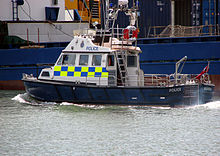 Police harbour patrol boat in Poole Harbour, Dorset
Police harbour patrol boat in Poole Harbour, DorsetHer Majesty's Inspectorates of Constabulary[edit]
Her Majesty's Inspectorates of Constabulary (HMIC) are the official bodies responsible for the examination and assessment of police forces to ensure their requirements are met as intended.
There are two similarly named organisations:
- Her Majesty's Inspectorate of Constabulary and Fire & Rescue Services (HMICFRS) - this organisation is responsible to the Home Office for police forces in England and Wales. It also inspects, by invitation, various UK special police forces and elements of the Service (Military) Police. Since 2004, HMIC has also had responsibility for examining HM Revenue and Customs and the Serious Organised Crime Agency. Inspection services have been provided on a non-statutory basis for the Police Service of Northern Ireland. Since July 2017 it has also become responsible for inspecting Fire & Rescue Services in England.
- Her Majesty's Inspectorate of Constabulary for Scotland (commonly known as HMICS) - this organisation is responsible to the Scottish Government and examines the Police Service of Scotland and the Scottish Police Authority.
Crown dependencies and overseas territories[edit]
The Crown dependencies and British Overseas Territories have their own police forces, the majority of which use the British model. Because they are not part of the United Kingdom, they are not answerable to the British Government; instead they are organised by and are responsible to their own governments (an exception to this is the Sovereign Base Areas Police; as the SBAs' existence is solely for the benefit of the British armed forces and do not have full overseas territory status, the SBA Police are responsible to the Ministry of Defence). Because they are based on the British model of policing, these police forces conform to the standards set out by the British government, which includes voluntarily submitting themselves to inspection by the HMIC.[77] Their vehicles share similarities with the vehicles owned by forces based in the UK, such as the use of Battenburg markings.
List of British Overseas Territories Police Services/Forces:
The fourteen British Overseas Territories are:[78]
List of forces for the Crown Dependencies
| Name | Flag | Arms | Location | Title of Monarch | Forces | Notes | Capital |
|---|---|---|---|---|---|---|---|
| Bailiwick of Guernsey | Guernsey | English Channel | Duke of Normandy | States of Guernsey Police Service | Includes three distinct types of Special Constables | Saint Peter Port (capital of the whole Bailiwick and of Guernsey also) | |
| Alderney | Saint Anne | ||||||
| Sark | The Seigneurie (de facto; Sark does not have a capital city) | ||||||
| Bailiwick of Jersey | States of Jersey Police Honorary Police (Jersey) | The Honorary Police are unpaid, elected officials of each parish | Saint Helier | ||||
| Isle of Man | Irish Sea | Lord of Mann | Isle of Man Constabulary | Douglas |
Map[edit]
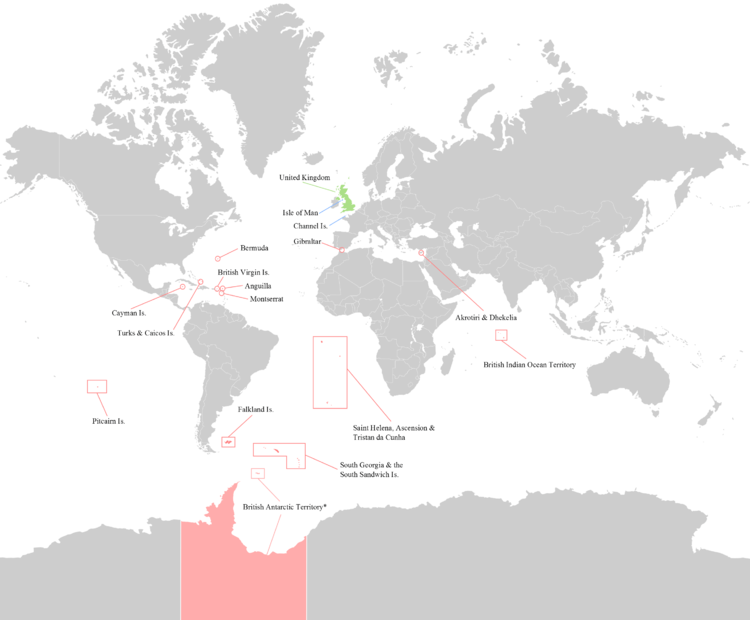 British Overseas Territories United Kingdom Crown dependencies
British Overseas Territories United Kingdom Crown dependenciesOperations[edit]
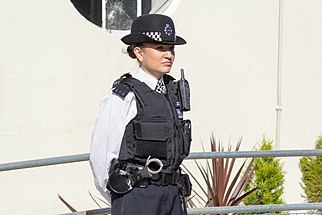 A Met Police officer in standard uniform. Female officers wear a bowler cap, as opposed to a peaked cap or custodian helmet.
A Met Police officer in standard uniform. Female officers wear a bowler cap, as opposed to a peaked cap or custodian helmet.Ranks[edit]
Main article: Police ranks of the United KingdomThroughout the United Kingdom, the rank structure of police forces is identical up to the rank of Chief Superintendent. At higher ranks, structures are distinct within London where the Metropolitan Police Service and the City of London Police have a series of Commander and Commissioner ranks as their top ranks whereas other UK police forces have assistants, deputies and a Chief Constable as their top ranks. All Commissioners and Chief Constables are equal in rank.
Police Community Support Officers (PCSOs) were introduced following the passing of the Police Reform Act 2002, although some have criticised these as for being a cheap alternative to fully trained police officers.[79]
Uniform and equipment[edit]
Main articles: Police uniforms and equipment in the United Kingdom, Police use of firearms in the United Kingdom, and Police vehicles in the United KingdomUniforms, the issuing of firearms, type of patrol cars, and other equipment, varies by force.
The custodian helmet which is synonymous with the "bobby on the beat" image is frequently worn by male officers in England and Wales (and formerly in Scotland), while the equivalent for female officers is the "bowler" hat. The flat peaked cap is worn by officers on mobile patrol and higher-ranking officers.[80]
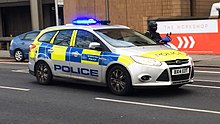 A typical Metropolitan Police response vehicle.
A typical Metropolitan Police response vehicle.Unlike police in most other developed countries, the vast majority of British police officers do not carry firearms on standard patrol; they carry an ASP baton and CS gas or PAVA spray. Officers are becoming increasingly trained in the use of an equipped with the TASER X2 as another tactical option.[81]
Firearms[edit]
Every territorial force has a specialist Firearms Unit,[82] which maintains armed response vehicles to respond to firearms-related emergency calls. The Police Service of Northern Ireland, Belfast International Airport Constabulary, Belfast Harbour Police, Civil Nuclear Constabulary and the Ministry of Defence Police are routinely armed.
London's Metropolitan Police firearms unit is the Specialist Firearms Command (SCO19), but every force in the United Kingdom maintains its own armed unit. Metropolitan and City of London Police operate with three officers per armed response vehicle, composed of a driver, a navigator, and an observer who gathers information about the incident and liaises with other units. Other police forces carry two authorised firearms officers instead of three.
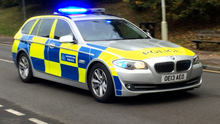 A BMW 5 series of the Metropolitan Police. Many forces utilise these as Roads Policing and area car units.
A BMW 5 series of the Metropolitan Police. Many forces utilise these as Roads Policing and area car units.Armed police carry various weapons, ranging from semi-automatic carbines like the Heckler & Koch MP5, H&K G36 and SIG MCX to specialist weapons like the Heckler & Koch PSG1 sniper rifles, baton guns (which fire baton rounds) and Remington pump-action shotguns. Marksmen in the London Metropolitan Police,[83] Police Service of Northern Ireland and other forces also use Accuracy International Arctic Warfare sniper rifles. All officers also carry a sidearm, typically the Glock 17 or a member of SIG Sauer's handgun family. Since 2009 Tasers have been issued to armed officers as an alternative to deadly force.[citation needed]
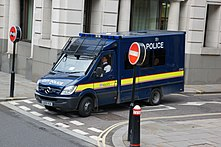 A City of London Police public order officer carrier.
A City of London Police public order officer carrier.Vehicles[edit]
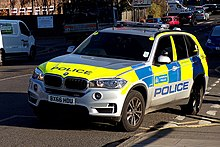 An ARV of the Metropolitan Police.
An ARV of the Metropolitan Police.The majority of officers on mobile patrol will do so in a marked police vehicle, namely an Incident Response Vehicle (IRV). Officers typically hold a 'response' permit, allowing them to utilise blue lights and sirens to make an emergency response. Some officers may not have undergone the additional training, and as such are only permitted to use emergency equipment when positioned at a scene or to pull over a vehicle. Officers who have undergone additional training to reach 'initial pursuit phase' standard are allowed to pursue vehicles, should they fail to stop. Common vehicles used as IRVs include the Vauxhall Astra, Vauxhall Insignia, Ford Focus and Peugeot 308SW. Vans, like the Ford Transit, are used as IRVs and, more specifically, to transport arrested suspects in a cage, who are unsuitable to be taken to custody in a car.
Some forces utilise Area Cars in addition to IRVs. Like IRVs, they respond to 999 calls and are manned by officers from response teams. However, officers are trained as 'advanced' drivers – allowing them to drive high-performance vehicles and pursue fleeing vehicles in the tactical phase of a pursuit. Some drivers may also be trained in skills like Tactical Pursuit and Containment (TPAC). Vehicles used as area cars commonly include the BMW 5 Series and Škoda Octavia VRS.
In addition, forces' specialist units utilise a wide variety of vehicles to help perform their role effectively. Roads Policing Units (RPU) utilise vehicles like the BMW 3 Series and BMW 5 Series to primarily enforce traffic laws and pursue fleeing suspects. Armed Response Vehicles (ARV), such as the BMW X5, are used to transport armed officers and carry weaponry. Tactical/operational support units use Mercedes-Benz Sprinter and Volkswagen Crafter vans, equipped with windscreen cages and/or reenforced glass, to transport officers into public order situations.
Forces also utilise unmarked vehicles for a wide-variety of roles. Covert surveillance vehicles are typically not fitted with any emergency equipment, as it is not necessary. Some forces utilise unmarked response vehicles to aid in proactive work. Similarly, some roads policing vehicles and ARVs are unmarked to help officers identity offences and use preemptive tactics to stop a suspect fleeing. Additionally, some forces have dedicated road crime units who use high-performance vehicles – like the Audi S3, Golf R and Ford Focus RS – to primarily focus on organised criminals using the road committing offences.
Initial training[edit]
England and Wales[edit]
There are three curricula for new police constables, special constables and police community support officers:[84]
- Initial Police Learning and Development Programme (IPLDP) for police constables
- Initial Learning for the Special Constabulary (IL4SC) for special constables
- PCSO National Learning Programme for police community support officers
Initial Police Learning and Development Programme[edit]
Main article: Initial Police Learning and Development ProgrammeSuccessful completion of the IPLDP over two years will result in a (mandatory) Diploma in Policing (Level 3 Qualifications and Credit Framework) consisting of ten mandatory units.
Initial Learning for the Special Constabulary[edit]
Derived from the IPLDP and although not linked to a formal qualification as such; IL4SC requires the learning outcomes and National Occupational Standards (NOSs) are met in order to become compliant. This curriculum will bring an officer to the 'point of safe and lawful accompanied patrol'.[85] This course equates to roughly 3.5 weeks of direct learning.
PCSO National Learning Programme[edit]
Successfully completion of the PCSO NLP over a period of six months to a year will result in a non-mandatory Certificate in Policing and this equates to 10 weeks of direct learning and consists of six mandatory units. Four of these units also feature within the IPLDP and being a QCF qualification, this can allow for officers wishing to become police officers for 'Recognition of Prior Learning' (RPL) and the transfer of such units to the IPLDP scheme.[84]
Scotland[edit]
All initial probationer training in Scotland is undertaken at the Scottish Police College (or SPC) at Tulliallan Castle. Recruits initially spend 12 weeks at the SPC before being posted to their divisions and over the next two years return to the SPC a number of times to complete examinations and fitness tests.[86] Training is composed of four distinct modules undertaken at various locations with some parts being delivered locally and some centrally at the SPC.[87]
Training for Special Constables is delivered locally at seven locations throughout Scotland over a series of evenings and/or weekends. The training is split into two parts, with the first phase being delivered in a classroom environment before being sworn in as a Special Constable and the second phase is delivered after being sworn in. Upon successful completion of both parts of the training programme Special Constables are awarded a certificate of achievement and would be eligible to complete an abbreviated course at the Scottish Police College should they later wish to join the Police Service of Scotland as a regular officer.[88]
Organisation of police forces[edit]
As all police forces are autonomous organisations there is much variation in organisation and nomenclature, however outlined below are the main strands of policing that makes up police forces:
- All police forces have teams of officers who are responsible for general beat duties and response to emergency and non-emergency calls from the public. These officers are generally the most visible and will invariably be the first interface a member of the public has with police. In general terms these officers will normally patrol by vehicle (though also on foot or bicycle in urban areas). They will generally patrol a sub-division or whole division of a police force area or in the case of the Metropolitan Police Service, a borough. Nearly all police officers begin their careers in this area of policing, with some moving on to more specialist roles. The Metropolitan Police Service calls this area of policing 'Response Teams', whilst other forces use terms such as 'patrol', 'section' and other variations.
- Most local areas or wards in the country have at least one police officer who is involved in trying to build links with the local community and resolve long-term problems. In London, the Metropolitan Police Service addresses this area of policing with Safer Neighbourhood Teams. This entails each political ward in London having a Police Sergeant, two police constables and a few PCSOs who are ring fenced to address problems and build community links in their respective wards. Other police forces have similar systems but can be named 'Area officers', 'Neighbourhood officers', 'Beat Constables' and a number of other variations.
- Criminal Investigation Departments (CID) can be found in all police forces. Generally these officers deal with investigations of a more complex, serious nature, however this again can differ from force to force. Most officers within this area are detectives. Depending on the force in question this area of policing can be further divided into a myriad of other specialist areas such as fraud. Smaller forces tend to have detectives who deal with a wide range of varied investigations whereas detectives in larger forces can have a very specialist remit.
- All police forces have specialist departments that deal with certain aspects of policing. Larger forces such as Greater Manchester Police, Strathclyde Police and West Midlands Police have many and varied departments and units such as traffic, firearms, marine, horse, tactical support all named differently depending on the force. Smaller forces such Dyfed Powys Police and Warwickshire Police will have fewer specialists and will rely on cross training, such as firearms officers also being traffic trained officers. The Metropolitan Police, the largest force in the country, has a large number of specialist departments, some of which are unique to the Metropolitan Police due to policing the capital and its national responsibilities. For example, the Diplomatic Protection Group and Counter Terrorism Command.
Fixated Threat Assessment Centre[edit]
Main article: Fixated Threat Assessment CentreIn the United Kingdom, the Fixated Threat Assessment Centre is a joint police/mental health unit set up in October 2006 by the Home Office, the Department of Health and Metropolitan Police Service to identify and address those individuals considered to pose a threat to VIPs or the Royal Family. [89] They may then be referred to local health services for further assessment and potential involuntary commitment. In some cases, they may be detained by police under the section 136 powers of the Mental Health Act 1983 prior to referral.
Border Force[edit]
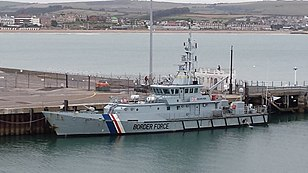 A Border Force patrol vessel.See also: UK Visas and Immigration and UK Border Force, previously UK Border Agency
A Border Force patrol vessel.See also: UK Visas and Immigration and UK Border Force, previously UK Border Agency
As part of the wide-ranging review of the Home Office, the then Home Secretary, John Reid, announced in July 2006 that all British immigration officers would be uniformed. On 1 April 2007 the Border and Immigration Agency (BIA) was created and commenced operation. However, there were no police officers in the Agency, a matter that attracted considerable criticism when the Agency was established - agency officers have limited powers of arrest. Further powers for designated officers within the Agency, including powers of detention pending the arrival of a police officer, were introduced by the UK Borders Act 2007.[90]
The Government has effectively admitted the shortcomings of the Agency by making a number of fundamental changes within a year of its commencement. On 1 April 2008 the BIA became the UK Border Agency following a merger with UKvisas, the port of entry functions of HM Revenue and Customs. The Home Secretary, Jacqui Smith, announced that the UK Border Agency (UKBA) "...will bring together the work of the Border and Immigration Agency, UK Visas and parts of HM Revenue and Customs at the border, [and] will work closely with the police and other law enforcement agencies to improve border controls and security."[91]
Within months of this, the Home Secretary revealed (in a 16-page response to a report by Lord Carlile, the independent reviewer of UK terrorism legislation) that the Home Office will issue a Green Paper proposing to take forward proposals by the Association of Chief Police Officers (England & Wales) for the establishment of a new 3,000-strong national border police force to work alongside the Agency.[92][93]
Following a major enquiry into the UK Border Agency that exposed significant flaws in the operation of border controls, the Home Secretary, Theresa May, announced in 2012 that the Border Force, which is responsible for manning all points of entry into the United Kingdom, would be split from the control of the UKBA and become a separate organisation with direct accountability to ministers and a "law-enforcement ethos".[94] Brian Moore, the former Chief Constable of Wiltshire Police, was appointed as the first head of the new UKBF.[95]
Overseas police forces in the UK[edit]
There are certain instances where police forces of other nations operate in a limited degree in the United Kingdom:
- The Police aux Frontières or PAF (French Border Police), a division of the Police Nationale, is permitted to operate in regard to Eurostar rail services through the Channel Tunnel. This includes on Eurostar trains to London, within the international terminal at St Pancras Station, at Ebbsfleet International and Ashford International railway stations, and at the Cheriton Parc Le Shuttle terminal (alongside French Customs officials). The PAF also operate at Dover Ferry terminals. This arrangement is reciprocated to the British Transport Police, UK Border Agency, and UK Customs Officers on Paris bound trains and within the terminal at Paris Gare du Nord, Coquelles (Le Shuttle), Gare de Lille-Europe, Bruxelles-Midi/Brussel-Zuid and the Calais, Dunkerque, and Boulogne ferry terminals.[96] The French police officers, who carry firearms while on duty in France, are not permitted to carry their firearms in the London Terminal; the firearms must be left on the train.
- Garda Síochána (Irish Police), under an agreement between the Republic of Ireland and the United Kingdom, has the right, alongside the Radiological Protection Institute of Ireland, to carry out inspections of the Sellafield nuclear facility in Cumbria.[97]
- In 2006 a small number of officers from the Policja (Polish Police) were seconded to the North Wales Police to assist with the supervision of foreign (largely eastern European) truck traffic largely on European route E22 (the A55 road).[98] The Chief Constable of North Wales has publicly stated (November 2006) that he is considering directly recruiting a small number of officers from Poland to assist with policing the substantial population of Polish people that have migrated to his area since Poland's accession to the EU in 2004.[99]
- Military Police of forces present in the UK within the terms of the Visiting Forces Act 1952 are permitted to travel to/from relevant premises in uniform and their (usually distinctive) vehicles will occasionally be seen. Their powers (including the carrying of firearms) are generally limited by that and other legislation to those necessary for the performance of duties related to their own forces and to those possessed by the general public.
Police force mergers[edit]
As of 2013 there were 45 territorial police forces in the UK. The territorial English and Welsh police forces were created in their current form by amalgamations made by either the Police Act 1964 or the Local Government Act 1972. Scotland has since merged its 8 territorial forces into one. Northern Ireland has always had a single police force since the Partition of Ireland in 1922.
Scotland[edit]
In 2013, the 8 territorial police forces in Scotland were merged into a single Scottish police force, named "The Police Service of Scotland", or colloquially Police Scotland. Merging these forces had been first mooted in 2010, and was supported by the Scottish National Party, Scottish Labour Party and Scottish Conservative Party ahead of the 2011 Scottish Parliament election.[100] After a consultation process,[101][102] the Scottish Government confirmed on 8 September 2011 that a single police service would be created in Scotland.[103] The Scottish Government stated that "reform will safeguard frontline policing in communities by creating designated local senior officers for every council area with a statutory duty to work with councils to shape local services. Establishing a single service aims to ensure more equal access to national and specialist services and expertise such as major investigation teams and firearms teams, whenever and wherever they are needed."[104] The Police and Fire Reform (Scotland) Bill was published in January 2012[105] and was approved on 27 June 2012 after scrutiny in the Scottish Parliament.[104] The Bill received Royal Assent as the Police and Fire Reform (Scotland) Act 2012. This created a force of approximately 17,000 police officers, the second largest in the United Kingdom after the Metropolitan Police in London.[106][107]
In March 2015, following the transfer of police oversight powers to the Scottish Government,[108] the Justice Secretary announced proposals to further unify policing in Scotland by merging the British Transport Police's operations north of the border with Police Scotland.[109] This proposal subsequently came in for significant criticism from both the rail industry and unions.[110][111]
Proposed mergers for England and Wales[edit]
In 1981 James Anderton, Chief Constable of Greater Manchester Police, called for the number of forces to be reduced to 9 in England (one for each Region) and 1 for Wales.[112] A 2004 proposal by the Police Superintendents' Association for the creation of a single national police force, similar to Garda Síochána na hÉireann was objected to by the Association of Chief Police Officers. The government did not accept the proposal at the time.[113]
From 2005 to 2006, the government considered merging several territorial police forces in England and Wales. The review only concerned policing in outside of Scotland, Northern Ireland and Greater London. Likewise, the major non-territorial forces (British Transport Police, Civil Nuclear Constabulary, Ministry of Defence Police) are responsible to other government departments, and would not have been affected either. The primary argument for merging forces is that forces with 4,000 or more officers would perform better and could save costs.[114] The view was supported by HM Inspectorate of Constabulary, who said in September 2005 that the existing structure was "no longer working".[115]
Merger proposals were announced by the Home Secretary in early 2006. They proposed reducing the number of police forces to less than 25, with Wales and several Regions of England having one force each.[116][117][118][119][120][121] The consultation period on this second batch of mergers started on 11 April 2006, and would have finished on 11 August, with a target of April 2008 for the mergers coming into effect.[122]
On 20 June 2006 the new Home Secretary, John Reid, announced that the contested mergers would be delayed for further discussion.[123] The only merger agreed to was with Lancashire Constabulary and Cumbria Constabulary. On 12 July 2006, the Home Office confirmed that all the mergers were to be abandoned, with the entire proposal taken back for consultation.[124]
Greater London[edit]
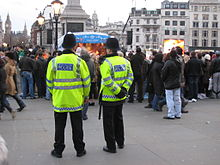 Metropolitan Police officers on the beat in London's Trafalgar Square
Metropolitan Police officers on the beat in London's Trafalgar SquareOne of the most common merger proposals is to merge the City of London Police and London operations of the British Transport Police into the Metropolitan Police.
The 2005-06 merger proposals had not included Greater London. This was due to two separate reviews of policing in the capital - the first was a review by the Department of Transport into the future role and function of the British Transport Police. The second was a review by the Attorney-General into national measures for combating fraud (the City of London Police is one of the major organisations for combating economic crime).[125] Both the Metropolitan Police Commissioner, Sir Ian Blair, and the Mayor, Ken Livingstone, stated that they would like to see a single police force in London, with the Metropolitan Police also absorbing the functions of the British Transport Police in London.[126] However, the proposal to merge both the BTP and City forces with the Met caused significant criticism from several areas; the House of Commons Transport Select Committee severely criticised the idea of the Metropolitan Police taking over policing of the rail network in a report published on 16 May 2006,[127] while the City of London Corporation and several major financial institutions in The City made public their opposition to the City Police merging with the Met.[128] In a statement on 20 July 2006, the Transport Secretary announced that there would be no structural or operational changes to the British Transport Police, effectively ruling out any merger[129] The interim report by the Attorney General's fraud review recognised the role taken by the City Police as the lead force in London and the South-East for tackling fraud, and made a recommendation that, should a national lead force be required, the City Police, with its expertise, would be an ideal candidate to take this role.[130] This view was confirmed on the publication of the final report, which recommended that the City of London Police's Fraud Squad should be the national lead force in combatting fraud, to "act as a centre of excellence, disseminate best practice, give advice on complex inquiries in other regions, and assist with or direct the most complex of such investigations"[131]
Separate from the proposals raised by the Mayor of London and Metropolitan Police Commissioner was a plan by the government to reform policing in the Royal Parks. Since 1872 this had been the responsibility of the Royal Parks Constabulary. A report by former Metropolitan Police Assistant Commissioner Anthony Speed provided three options to reform the RPC, with the decision taken that it should be merged with the Metropolitan Police.[132] The Met took over responsibility for policing the Royal Parks on 1 April 2004 with the formation of the Royal Parks Operational Command Unit. The full merger and abolition of the Royal Parks Constabulary took place in May 2006.[133]
In May 2016, following his election, the Mayor of London Sadiq Khan ordered a review, led by Lord Harris, of London's preparedness in the face of potential terror attacks. Amongst the recommendations, which were published in October 2016, was a revisiting of the idea of merging the Metropolitan Police, City of London Police and British Transport Police. In commenting, both the City Police and BTP cautioned against the proposal.[134]
Funding[edit]
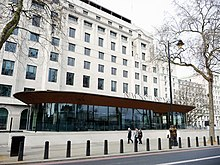 New Scotland Yard is the headquarters of the Metropolitan Police Service
New Scotland Yard is the headquarters of the Metropolitan Police ServiceThe police are funded both by central government and by local government.[135] Central government funding is calculated based by a formula, based on several population and socio-economic factors which are used to determine the expected cost of policing the area.[135]
For the 2017/18 fiscal year, the budget for local Police and Crime Commissioners to spend on police is £11 billion, with an extra £1.5 billion allocated to counter-terrorism and other special programmes.[136] The combined funding will reduce from £12.3 billion in 2017/18 to £11.6 billion in 2020/21. Her Majesty's Inspectorate of Constabulary (HMIC) estimates that officer numbers will fall by around 2%.
According to the National Audit Office, funding was decreased between 2011 and 2016 by 22% in real terms[135] and police officer numbers fell by 20,000 from 2010 to 2017.[137] Funding levels stayed the same in real terms between 2015 and 2018, with a decrease in central government funding made up for by an increase in local government funding.[138] Increased spending in some areas such as counter-terrorism has been offset by decreased spending in other departments.[139] In 2018 further funding cuts will force further cuts in the numbers of poice officers.[140] 80% of UK people believe Britain is less safe due to cuts to police funding.[141]
In 2017, a report from the Inspectorate found that most police forces were providing a good service, though it noted that some aspects such as investigations and neighbourhood policing were being compromised by "rationing" and cutbacks.[139] A report from the Inspectorate in March 2018 had similar findings; it reported improvement in neighbourhood policing and highlighted issues with response policing.[142][143] Several current and former chief constables were raising concerns about whether the police can meet foreseeable challenges with current levels of funding.[139][144][145]
Issues[edit]
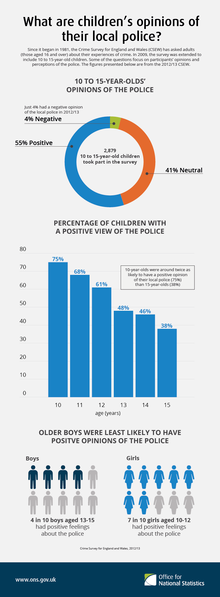
Deaths after contact with the police[edit]
The police service is sometimes criticised for incidents that result in deaths due to police firearms usage or in police custody, as well as the lack of competence and impartiality in investigations (in England and Wales only) by the Independent Police Complaints Commission after these events.[146] The Economist stated in 2009:
Bad apples ... are seldom brought to justice: no policeman has ever been convicted of murder or manslaughter for a death following police contact, though there have been more than 400 such deaths in the past ten years alone. The IPCC is at best overworked and at worst does not deserve the "I" in its name.
— The Economist[146]
In the year 2011/12 there were 15 deaths in or following police custody. There were two fatal police shootings and 39 people died from apparent suicide following contact with the police.[147]
In the year 2012/13 there were 15 deaths in police custody. Nearly half of those who died had known mental health issue and four of those who died had been restrained by police officers. There were 64 deaths by apparent suicide within 48 hours of release from police custody.[148]
In the year 2013/14 there were 11 deaths in or following police custody. The number of people recorded as having apparently committed suicide within 48 hours of release from police custody was 68, a ten-year high.[149]
In the year 2014/15 there were 17 deaths in or following police custody. There was one fatal police shooting and there were 69 apparent suicides following custody.[150]
Controversial shootings[edit]
Main article: Police use of firearms in the United Kingdom § Controversial shootingsThe policy under which police officers in England and Wales use firearms has resulted in controversy. Notorious examples include the Stephen Waldorf shooting in 1983, the deliberate fatal shootings of James Ashley in 1998, Harry Stanley in 1999, and Jean Charles de Menezes in 2005, and the accidental non-fatal shooting of Abdul Kahar in 2006.
Deaths in police custody[edit]
Main article: UK deaths in custodyFrom 1990 to July 2012, 950 deaths occurred in police custody.[151]
In 1997/98, 69 people died in police custody or following contact with the police across England and Wales; 26 resulted from deliberate self-harm.[152]
There are two defined categories of death in custody issued by the Home Office:[153]
Category A: This category also encompasses deaths of those under arrest who are held in temporary police accommodation or have been taken to hospital following arrest. It also includes those who die, following arrest, whilst in a police vehicle.
- they have been taken to a police station after being arrested for an offence, or
- they are arrested at a police station after attending voluntarily at the station or accompanying a constable to it, and is detained there or is detained elsewhere in the charge of a constable, except that a person who is at a court after being charged is not in police detention for those purposes.
Category B: Where the deceased was otherwise in the hands of the police or death resulted from the actions of a police officer in the purported execution of his duty.
- when suspects are being interviewed by the police but have not been detained;
- when persons are actively attempting to evade arrest;
- when persons are stopped and searched or questioned by the police; and
- when persons are in police vehicles (other than whilst in police detention).
Hundreds of people kill themselves within 48 hours of being released from police custody.[154]
Civil unrest and corruption[edit]
Evidence of corruption in the 1970s, serious urban riots and the police role in controlling industrial disorder in the 1980s, and the changing nature of police procedure made police accountability and control a major political football from the 1990s onwards.
- The coal miners' strike (1984–1985) saw thousands of police from various forces deployed to maintain public order and to prevent intimidation of those continuing to work during a national strike by miners, frequently resulting in violent confrontation.
- Undercover TV programmes, the BBC's 2003 The Secret Policeman[155] and the Channel 4 Dispatches 2006 Undercover Copper[156] raised questions of standards within UK police forces.
Racism[edit]
The Macpherson Report coined the phrase "institutionalised racism" to describe policies and procedures that adversely affect persons from ethnic minority groups after the death of Stephen Lawrence. Some commentators and academics have claimed that political correctness and excessive sensitivity to issues of race and class have reduced the effectiveness of the police force, not least for people living in deprived areas or members of minority groups themselves.[citation needed]
In 2003, ten police officers from Greater Manchester Police, North Wales Police and Cheshire Constabulary were forced to resign after a BBC documentary, The Secret Policeman, shown on 21 October, alleged racism among recruits at Bruche Police National Training Centre at Warrington. On 4 March 2005 the BBC noted that minor disciplinary action would be taken against twelve other officers (eleven from Greater Manchester Police and one from Lancashire Constabulary) in connection with the programme, but that they would not lose their jobs. In November 2003, allegations were made that some police officers were members of the British National Party.
In June 2015, the Metropolitan Police Commissioner, Sir Bernard Hogan-Howe, said there was "some justification" in claims that the Metropolitan Police Service is "institutionally racist":
I have always said if other people think we are institutionally racist then we are. It is no good me saying we are not and then saying you must believe me, it’s nonsense, if they believe that. I think it is a label but in some sense there is a truth there for some people … You're very much more likely to be stopped and searched if you're a young black man. I can't explain that fully. I can give you reasons but I can't fully explain it. So there is some justification ... I think in some ways society is institutionally racist. We see lack of representation in many fields, of which the police are one.[157][158]
Privacy[edit]
At the beginning of 2005 it was announced that the Police Information Technology Organisation (PITO) had signed an eight-year £122 m contract to introduce biometric identification technology.[159] PITO are also planning to use CCTV facial recognition systems to identify known suspects; a future link to the proposed National Identity Register has been suggested by some.[160]
Freedom of speech[edit]
The police have sometimes been accused of infringing on free speech. In December 2005, author Lynette Burrows was interviewed by police after expressing her opinion on BBC Radio 5 Live that homosexuals should not be allowed to adopt children.[161] The following month, Sir Iqbal Sacranie was investigated by police for stating the Islamic view that homosexuality is a sin.[162]
Photography of police[edit]
Main article: Counter-Terrorism Act 2008 § Photographs of police officers in public placesSection 76 of the Counter-Terrorism Act 2008 came into force on 15 February 2009[163] making it an offence to elicit, attempt to elicit, or publish information "...of a kind likely to be useful to a person committing or preparing an act of terrorism" about:[164] a member of Her Majesty's Armed Forces; a constable, the Security Service, the Secret Intelligence Service, or Government Communications Headquarters. Any person found guilty faces 10 years imprisonment and an unlimited fine.[164] It is a defence for a person charged with this offence to prove that they had a reasonable excuse for their action.[164] It is not otherwise illegal to photograph or film a police officer in a public place per se.[165][166] Any film or photography recorded whilst a constable is dealing with an incident may be seized as it becomes evidence under section 19 of PACE 1984.
Policing of public protests[edit]
Public order policing presents challenges to the approach of policing by consent.[167][168] In April 2009, a total of 145 complaints were made following clashes between police and protesters at the G20 summit.[169] Incidents including the death of 47-year-old Ian Tomlinson,[170] minutes after an alleged assault by a police officer,[171] and a separate alleged assault on a woman by a police officer,[172] has led to criticism of police tactics during protests.[173] In response, Metropolitan Police Commissioner Sir Paul Stephenson asked Her Majesty's Chief Inspector of Constabulary (HMIC) to review policing tactics,[174] including the practice of kettling.[175] These events sparked a debate in the UK about the relationship between the police, media and public, and the independence of the Independent Police Complaints Commission.[176] In response to the concerns, the Chief Inspector of Constabulary, Denis O'Connor, published a 150-page report in November 2009 that aimed to restore Britain's consent-based model of policing.[177]
Police undercover conduct[edit]
During 2010 and 2011, it emerged that, while engaged in covert infiltration of protest groups, undercover police officers had entered into intimate relationships with a number of people on false pretences and under assumed aliases, in some cases sharing a home, making plans for weddings, or fathering children, only to vanish after some years when their role was complete. In 2015 a public inquiry under a senior judge was announced. In November 2015 the Metropolitan Police published an unreserved apology in which it exonerated and apologized to those women who had been deceived and stated the methodology had constituted abuse and a "gross violation" with severely harmful effects, as part of a settlement of their cases. In 2016 new cases continued to come to light.
Capacity to solve crimes[edit]
Recorded crime rose by almost a third in three years to 2018, but charges or summons dropped by 26% and arrests also fell. Neighbourhood policing capacity has fallen on average by at least a fifth since 2010. Neighbourhood policing is important in dealing with terrorism and gang crime, especially in communities where the police are distrusted. Yvette Cooper said the police were, "performing a remarkable public service in increasingly difficult circumstances" though they were, "badly overstretched" and responding with difficulty to increasing challenges like online fraud and online child abuse. Only a very small proportion of online fraud cases are investigated and the police are, "woefully under-resourced" for the number of online child sexual abuse investigations they must undertake. Che Donald of the Police Federation of England and Wales said the government should acknowledge the, "true cost of policing" or officers would be unable to keep the public safe.[178]
Police sex abuse allegations[edit]
In 2016, allegations of serious sexual abuse were made against hundreds of police officers in England and Wales, with several forces in England and Wales receiving 436 allegations of abuse of power for sexual gain against 436 police officers, including 20 police community support officers and eight staff in the two years to March 2016.[179][180] Mike Cunningham, inspector of constabulary and former chief constable of Staffordshire police said: "It's the most serious form of corruption. It is an exploitation of power where the guardian becomes an abuser. What can be worse than a guardian abusing the trust and confidence of an abused person? There can be no greater violation of public trust".[179]
Brexit[edit]
If there is a no deal Brexit the UK may lose access to important cross border databases of criminals, which may make it harder for the police to keep the public safe. Police leaders warn of "a significant loss of operational capacity" if the UK leaves the EU without an agreement on policing. The Association of Police and Crime Commissioner sent a letter to Home Secretary, Sajid Javid stressing the need for co-operation with European policing and justice organizations after March 2019. The letter states 32 measures are currently used daily including the European Arrest Warrant, the Schengen Information System - a database giving alerts about individuals - and the European Criminal Records Information System. The letter stresses the importance and mutual benefit of continued cooperation between the UK and Europe to face mutual threats.[181][182]

